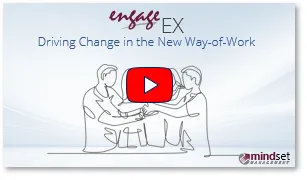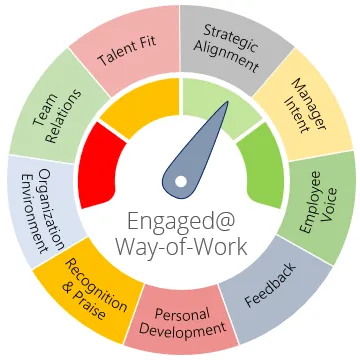
Mindset's Employee Engagement EX
Empower your employees and leaders with real-time analytics and data-driven insights to drive engagement
Highly engaged employees are not only more productive and loyal to their organizations, they are also more resilient and emotionally better prepared to deal with their new-way-of-work
Employee engagement can be defined as a measure of the emotional commitment of employees to the organization and its values, and their willingness to invest – at their own discretion – additional effort to help the organization achieve its goals. Engagement is seen as a long-term social contract between the employees and the organization – a two-way process where the organization commits and cares for the employees, who in turn give commitment and effort back to the organization.
Put simply, engagement will benefit your organization. In fact, hundreds of studies have shown that engaged employees are more productive, deliver better customer service, are more innovative, and are more likely to remain at your organization. With this in mind, most organizations are already doing something about engagement – albeit with varying degrees of success.
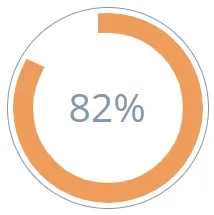
everybody agrees
82% of the 7 000 companies surveyed are already measuring engagement at least once or more per year
Predictions for 2021, Bersin by Deloitte
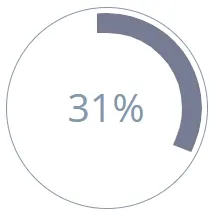
engagement stagnant
Only 31% of U.S & Canadian – and globally only 23% – of the workers surveyed are engaged
3 Key Insights Into the Global Workplace, Gallup 2024
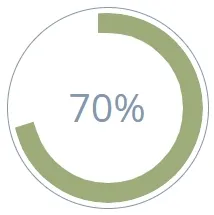
focus on managers
Managers account for at least 70% of the variance in employee engagement scores across business units
How to Engage Frontline Managers, Gallup 2024
Engagement 1.0: Setting a Baseline
The organizational engagement journey usually starts at what Josh Bersin describes as Engagement 1.0 (link): company-wide annual engagement surveys accompanied by carefully-crafted engagement strategies, action plans and management feedback sessions – which are then followed-up with annual or bi-annual remeasure surveys for comparison and benchmarking purposes.
A scientifically designed diagnostic engagement survey is the perfect tool to help set a an engagement baseline at your organization. Such a survey – together with the Engage platform – will provide you with both the context and tools to initiate targeted interventions that will have a sustainable impact on performance levels and overall productivity in your organization. A properly designed diagnostic survey will help you to:
- Focus your Approach – the survey will provide you with insight into the activities and drivers that impact employee engagement and performance at business unit and demographic level at your organization. It will help you to diagnose areas of risk and to isolate performance problems, as well as providing you with a better understanding of what drives talent retention and employee loyalty.
- Set a Benchmark – the survey will enable you to monitor, and track over time, the impact and progress of any changes or interventions that you have instituted. This will make targeted interventions much more effective.
- Quantify the Benefits – by correlating the survey results with other types of business metrics (e.g. customer satisfaction, absenteeism, defects or injury statistics), you will be able to quantify the competitive and financial gains – and ultimately the return on investment – incurred by the engagement interventions undertaken at your organization.
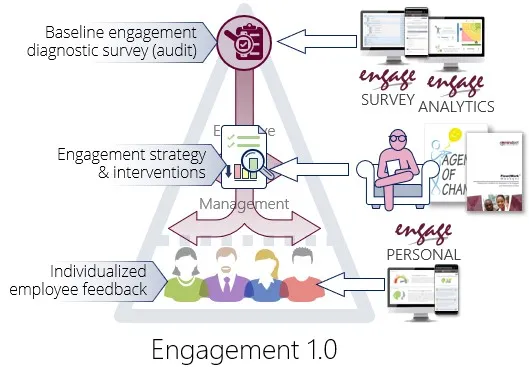
As an added bonus, Engage Personal will provide every member of your organization with the opportunity to take charge of their personal engagement journeys. The system will provide them with personalized feedback and recommendations designed to support them with the information they need to make a difference in their work life. Providing survey respondents with personalized feedback reports will not only incentivize and reward them for taking part in a survey, but will at the same time help to decentralize engagement by making it a talking point at all levels of the organization.
|
Book a free, no-obligation online demo of the Engage EX platform |
|
Contact us for more information or a quote for a turnkey solution |
Engagement 3.0: The Engaged Organizational Experience
Although annual surveys serve as a good baseline for measuring and comparing engagement levels, moving the engagement needle on a sustainable basis will require a more involved approach that will ultimately result in a change in leadership behavior. For engagement to be sustainable over the long term, it has to be approached strategically, creating an organizational culture and collaborative work environment where employees are genuinely involved, looked after, and cared for. Sustainable engagement, however, also requires employees who have taken ownership of their engagement, and transformational leaders at all levels of the organization who have developed habits of action around ensuring employees are happy, hardworking, and remain committed to the organization.
This is where Mindset’s Engaged Organizational Experience approach comes in. The approach – together with the Engage EX platform – have been specifically designed by a team of organizational psychologists and data scientists to help organizations instill engagement with the minimum effort as an organizational way-of-life.
|
Conducive work environment Measure, set a baseline and diagnose the issues that drive engagement, and develop an engagement strategy and action plan |
|
Track engagement at unit level Measure and track the impact of engagement interventions with regular and ad hoc pulse surveys at business unit level (more...») |
|
Change leadership behavior Equip managers at all levels with the data, tools and know-how to take ownership and drive engagement in their teams |
Get employee buy-in Empower employees with individualized engagement feedback reports so they can own their engagement |
Mindset’s Engaged Organizational Experience approach and Engage platform will help you to drive and improve engagement on a sustainable basis at all levels of your organization:
- Remeasure engagement surveys – regular follow-up diagnostic engagement surveys, preferably on an annual basis, will serve as a good audit of both the state of engagement in your organization and the efficacy and impact of engagement interventions at all levels of the organization. It will help you to identify areas of concern that need further attention and will at the same time provide you with the opportunity to update your engagement strategy and action plans.
- Individualized feedback – ongoing personalised feedback to all your employees will help to further decentralize and embed engagement by making sure that it remains a talking point at all levels of the organization. It can also serve as the basis for providing employees with contextualized learning content that has been adapted to suit your organizational culture and HR practices.
- Change leadership behavior – empower leaders at all levels with the data, tools and know-how so they can take ownership of the engagement levels of their business units or teams. Engage Insight will provide them with data-driven best-practices recommendations of what they need to do to drive engagement – based on their most recent survey results. It will also provide them with contextual learning content that can be adapted and aligned with the organizational HR policies and practices. To close the loop, the efficacy of interventions at business unit level should be followed-up and tracked with targeted pulse surveys.
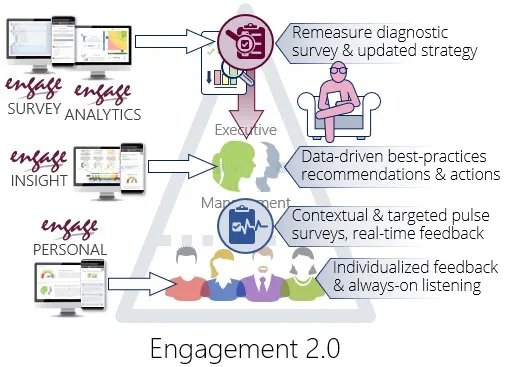
Mindset's Engagement Survey Models
Mindset’s scientifically designed and statistically validated Flow@Work employee engagement survey model, as well as it's Engaged@Way-of-Work wellbeing version, measure not only the levels of engagement in your organization, but also the factors that inhibit or drive engagement at business unit and demographic level so you know where to focus and what needs fixing:
-
The Indicators of Engagement measure the levels of engagement, i.e. the outcomes of engagement, or how engaged an employee or business unit is. The indicators of engagement is like a fuel gauge in a car: the needle shows you how much fuel you have left in the tank, but you can’t move the needle by tapping on the gauge with your finger.
-
The Drivers of Engagement are the contributing factors that have a direct impact on engagement levels, i.e. the issues that inhibit or drive engagement that you have to identify, diagnose and fix if you want to move the engagement needle and improve the levels of engagement (indicators). To use the fuel gauge analogy again: to move the needle of the fuel gauge, you have to diagnose the reason why the needle shows ‘empty’ – it could be because you have used up all the fuel, or there could be a leak somewhere in the system (fuel tank, fuel pump, engine etc.).
Mindset's Partner Engagement Models
Please note that the survey models shown below are the intellectual property of the respective Mindset Partners. The survey models are hosted and made available for use by other Mindset Partners and/or clients via the Engage platform, and may be subject to additional license fees as determined by the owner.
BDO: Unionized Workplace Engagement and Labor Relations Survey
The Unionized Workplace Employee Engagement and Labor Relations framework considers the collective context of a unionized organization, and accurately measures the workplace experiences that are most likely to impact engagement in organizations with a union presence. The framework replaces the traditional, often adversarial, labor relations approach with employee-oriented management strategies, and embodies an ideological shift in unionized environments, beyond a one-size-fits-all doctrine in pursuit of a pluralist outlook – a shift based on the premises that engagement is likely to occur if the employees’ needs for meaningfulness, safety and availability are satisfied.


